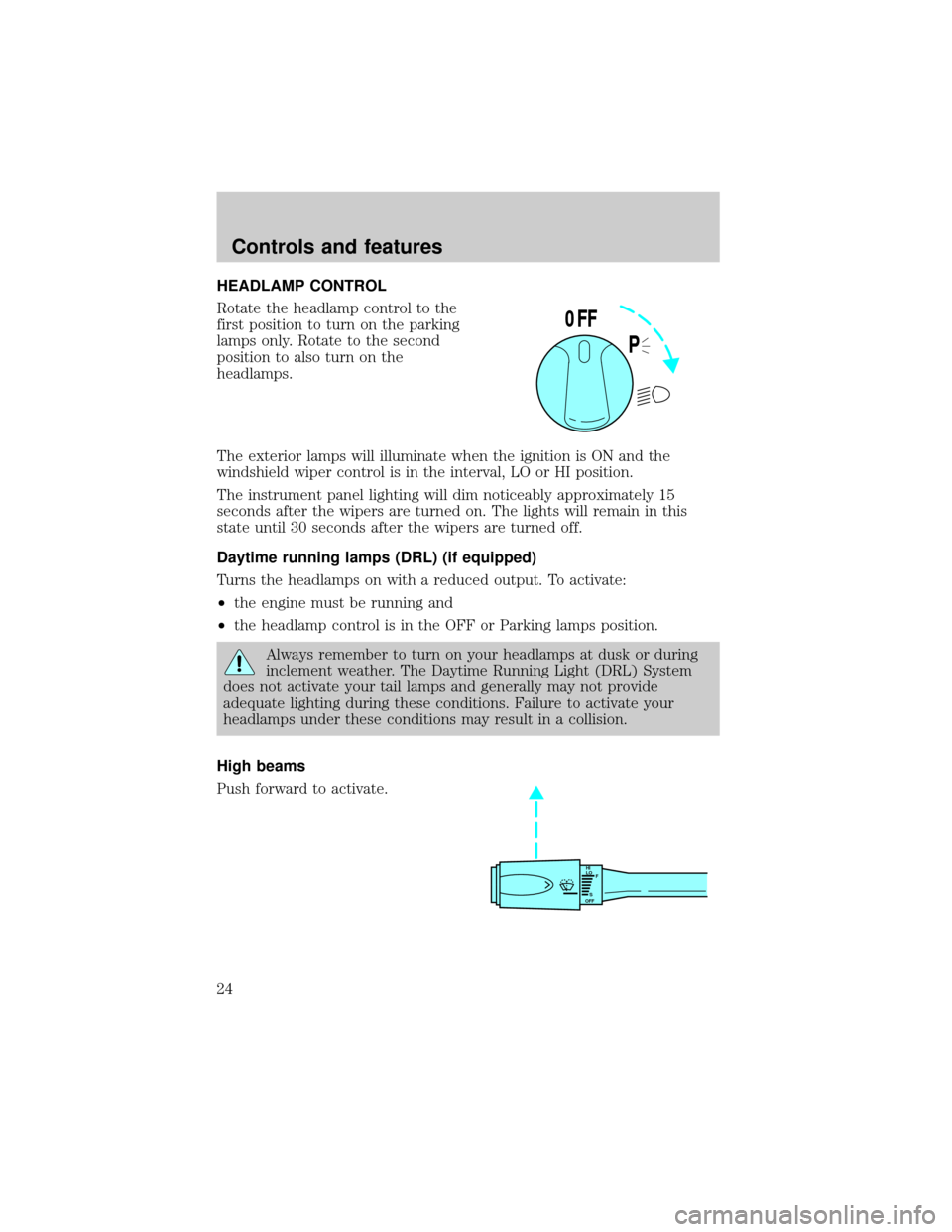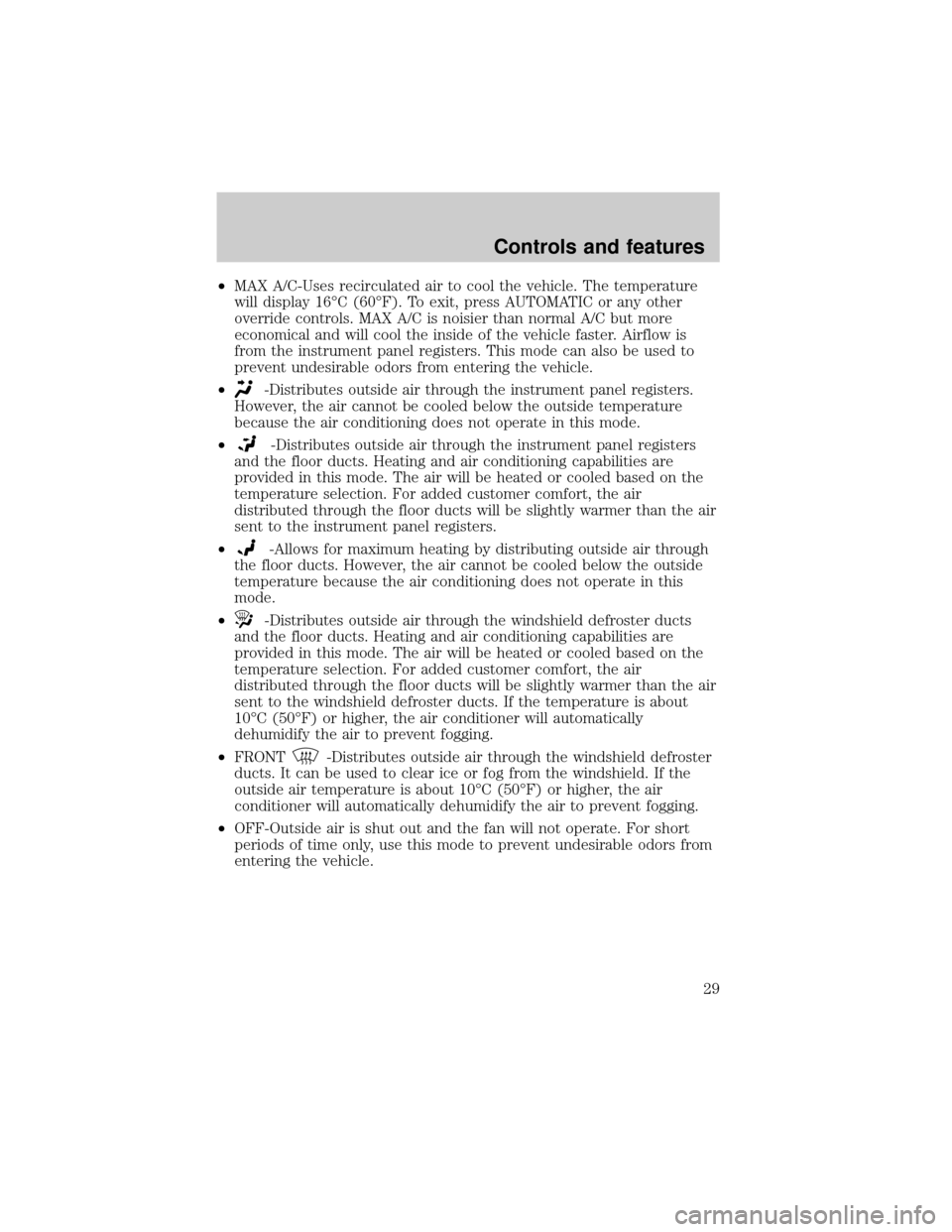Page 4 of 208
RESUME
SET ACCEL
COAST
OFF
ON
80
MPH km/h
ABS
P!BRAKE
+ –
RPMx1000NORM
T/C
OFF
CHEF
FILL ON RIGHT
SERVICE
ENGINE
SOON AIR
BAG TURN ON
HEAD
LAMPS0 123456
7
0 2060
80
100
1200 204060100
120
140
160
180
200
40
OFFHI
LO
P0FFLIGHTS
AUTO
LAMP
SRS
Headlamp
control
(pg. 24)
Turn signal and
wiper/washer
control
(pg. 48)Instrument
cluster
(pg. 6)
Driver air bag
(pg. 101) Speed control
(pg. 50) Instrument panel
dimmer switch
(pg. 25) Auto lamp (pg. 25)
* If equipped
Instrumentation
4
Page 18 of 208

under Operator Selectable Features. Refer to ªMessage Centerº in this
chapter for more information on the Message Center controls. The
Message Center has a Driver ID control, which when pressed, allows the
driver to select either Driver 1, Driver 2 or OFF. Selecting OFF will turn
the system OFF.
Operator selectable features
The Memory Profile System and the Memory Profile Systen with Driver
Select System access to the following the vehicle features:
²Express window
²Auto door locks
²Horn chirp
²Easy entry/exit seat access
²Reverse mirrors
²Adjustable ride (Driver Select System only)
²Adjustable steering
²Autolamp on/delay time
²Instrument panel dim control
²Driver's seat position
²Outside mirror position
Basic operation of Memory Profile System
In order for the system to be able to store or recall an individual's seat or
mirror position preferences, the Memory Profile must first recognize who
will be driving the vehicle. Drivers may identify themselves to the system
one of two ways:
²Pressing the unlock control on the appropriate remote transmitter key
(DRIVER MEMORY 1 or DRIVER MEMORY 2 is identified by the
number on the back of the remote transmitter) before opening the
driver's door.
²Entering either the DRIVER MEMORY 1 or DRIVER MEMORY 2
personalized code into the keyless entry keypad before opening the
driver's door. For information on programming personalized codes see
Keyless entry systemin theControl and featuressection.
Pressing OFF will turn the system off.
Instrumentation
18
Page 22 of 208

Adjustable steering
²Setting is saved as vehicle setting only.
²Vehicle with optional Driver Select System, setting may be saved to
either the DRIVER MEMORY 1 or 2 personalized profiles or as a
vehicle setting.
²Settings-low, normal, high
²Original setting-normal
²Setting adjustment made using: Message Center-VEHICLE
HANDLING/SELECT controls
Autolamp on/delay time
²Setting is saved as vehicle setting only.
²Vehicle with optional Driver Select System, setting may be saved to
either the DRIVER MEMORY 1 or 2 personalized profiles or as a
vehicle setting.
For information on autolamp on/delay seeAutolamp controlin the
Control and featuressection.
Instrument panel dim control setting
²Setting is saved as vehicle setting only.
²Vehicle with optional Driver Select System, setting may be saved to
either the DRIVER MEMORY 1 or 2 personalized profiles or as a
vehicle setting.
²Settings-variable
²Original setting-maximum
²Setting adjustment made using: Lighting Control Module-panel dim
control.
For information on instrument panel dim control seePanel dimmer
controlin theControl and featuressection.
Driver's seat position
²Setting may be saved to either the DRIVER MEMORY 1 or 2
personalized profiles or as a vehicle setting.
²Vehicle with optional Driver Select System, setting may be saved to
either the DRIVER MEMORY 1 or 2 personalized profiles or as a
vehicle setting.
Instrumentation
22
Page 24 of 208

HEADLAMP CONTROL
Rotate the headlamp control to the
first position to turn on the parking
lamps only. Rotate to the second
position to also turn on the
headlamps.
The exterior lamps will illuminate when the ignition is ON and the
windshield wiper control is in the interval, LO or HI position.
The instrument panel lighting will dim noticeably approximately 15
seconds after the wipers are turned on. The lights will remain in this
state until 30 seconds after the wipers are turned off.
Daytime running lamps (DRL) (if equipped)
Turns the headlamps on with a reduced output. To activate:
²the engine must be running and
²the headlamp control is in the OFF or Parking lamps position.
Always remember to turn on your headlamps at dusk or during
inclement weather. The Daytime Running Light (DRL) System
does not activate your tail lamps and generally may not provide
adequate lighting during these conditions. Failure to activate your
headlamps under these conditions may result in a collision.
High beams
Push forward to activate.
P
0FF
HI
LO
F
S
OFF
Controls and features
24
Page 25 of 208
Flash to pass
Pull toward you to activate and
release to deactivate.
PANEL DIMMER CONTROL
Use to adjust the brightness of the
instrument panel during headlight
and parklamp operation.
²Push up to brighten.
²Push down to dim.
AUTOLAMP CONTROL
The autolamp system provides light
sensitive automatic on-off control of
the exterior lights normally
controlled by the headlamp control.
The autolamp system also keeps the
lights on for a preselected period of
time after the ignition switch is
turned to OFF.
²To turn autolamps on, push the
control up toward the MAX position. As you press this switch, the
autolamp system's status will be displayed in the message center. The
system can be set to provide light for up to three minutes after you
turn the ignition OFF.
²To turn autolamps off, push the control down toward OFF.
HI
LO
F
S
OFF
PANEL
DIM
MAX
OFF
AUTO
LAMP
Controls and features
25
Page 29 of 208

²MAX A/C-Uses recirculated air to cool the vehicle. The temperature
will display 16ÉC (60ÉF). To exit, press AUTOMATIC or any other
override controls. MAX A/C is noisier than normal A/C but more
economical and will cool the inside of the vehicle faster. Airflow is
from the instrument panel registers. This mode can also be used to
prevent undesirable odors from entering the vehicle.
²
-Distributes outside air through the instrument panel registers.
However, the air cannot be cooled below the outside temperature
because the air conditioning does not operate in this mode.
²
-Distributes outside air through the instrument panel registers
and the floor ducts. Heating and air conditioning capabilities are
provided in this mode. The air will be heated or cooled based on the
temperature selection. For added customer comfort, the air
distributed through the floor ducts will be slightly warmer than the air
sent to the instrument panel registers.
²
-Allows for maximum heating by distributing outside air through
the floor ducts. However, the air cannot be cooled below the outside
temperature because the air conditioning does not operate in this
mode.
²
-Distributes outside air through the windshield defroster ducts
and the floor ducts. Heating and air conditioning capabilities are
provided in this mode. The air will be heated or cooled based on the
temperature selection. For added customer comfort, the air
distributed through the floor ducts will be slightly warmer than the air
sent to the windshield defroster ducts. If the temperature is about
10ÉC (50ÉF) or higher, the air conditioner will automatically
dehumidify the air to prevent fogging.
²FRONT
-Distributes outside air through the windshield defroster
ducts. It can be used to clear ice or fog from the windshield. If the
outside air temperature is about 10ÉC (50ÉF) or higher, the air
conditioner will automatically dehumidify the air to prevent fogging.
²OFF-Outside air is shut out and the fan will not operate. For short
periods of time only, use this mode to prevent undesirable odors from
entering the vehicle.
Controls and features
29
Page 31 of 208

²If your vehicle has been parked with the windows closed during hot
weather, the air conditioner will do a much faster job of cooling if you
drive for two or three minutes with the windows open. This will force
most of the hot, stale air out of the vehicle. Then operate the air
conditioner as you would normally.
²If the air conditioner works well in MAX A/C but not in normal A/C,
this may indicate that the cabin air filter (if equipped) needs to be
replaced.
²When placing objects on top of your instrument panel, be careful to
not place them over the defroster outlets. These objects can block
airflow and reduce your ability to see through your windshield. Also,
avoid placing small objects on top of your instrument panel. These
objects can fall down into the defroster outlets and block airflow and
possibly damage your climate control system.
REAR WINDOW DEFROSTER
The rear defroster control is located
on the instrument panel.
Press the rear defroster control to
clear the rear window of thin ice
and fog.
²The small LED will illuminate
when the rear defroster is
activated.
The ignition must be in the ON position to operate the rear window
defroster.
The defroster turns off automatically after 10 minutes or when the
ignition is turned to the OFF position. To manually turn off the defroster
before ten minutes have passed, push the control again.
FRONT
REAR
Controls and features
31
Page 48 of 208

WINDSHIELD WIPER/WASHER CONTROLS
Rotate the windshield wiper control
to the desired interval, low or high
speed position.
The bars of varying length are for
intermittent wipers. When in this
position rotate the control upward
for fast intervals and downward for
slow intervals.
Push the control on the end of the
stalk to activate washer. Push and
hold for a longer wash cycle. The
washer will automatically shut off
after ten seconds of continuous use.
Windshield wiper/washer features
The exterior lamps will illuminate when the ignition is ON and the
windshield wiper control is in the interval, LO or HI position.
The instrument panel lighting will dim noticeably approximately 15
seconds after the wipers are turned on. The lights will remain in this
state until 30 seconds after the wipers are turned off.
TURN SIGNAL CONTROL
²Push down to activate the left
turn signal.
²Push up to activate the right turn
signal.
Cornering lamps (if equipped)
When the turn signal is used when the headlamps are on, the cornering
lamps will light either the right or left side depending on the direction of
the turn.
HI
LO
F
S
OFF
HI
LO
F
S
OFF
HI
LO
F
S
OFF
Controls and features
48